I gathered a few interviews, articles on the web about Dream for you guys to check out. Last year around this time wrote a blog which still holds true today (written below), im not much for words right now this early in the morning so here yall go. Remberance is Power yall..if you havent woken up from the matrix just yet, maybe this will inspire you to. till then, peace be upon you all, and to the late, great, King Mike Dream of OAKLAND, and his family, crew, friends, and fans.
peace, skeee
Wednesday, February 15, 2006
Rest In Power King Dream TDK OAKLAND
www.DREAMTDK.com
2/17/00 marks the day KING DREAM of Oakland was taken away from us. I never got a chance to meet him personally, but have been privilaged and honored to meet up with his crew and build with his family. Words cant express how much of a street hero Dream is to me and for all my Filipino people caught up in the struggle.
Dream taught me a lot of things through interviews I read and saw him do in videos. Things that stood out the most to me about Dream is when he said how important it was to rep and be proud of who you are (what ever race you might be), and where you grew up (your hood). Dream also stressed the fact that whatever element you did in HIP HOP to pay homage to where it all came from by learning the history from NYC. His words influence my work to this very day.
I used to always see his pieces and handstyles every where when he was around in awe. he always added a R.I.P Plan Bee, Pak 1, etc. of all the fallen soldiers from his camp and I have been inspired to do the same for him on every peice of work I do from now until my own passing day. Dream, thank you for helping me be proud of what and who I am. One day ima find you and shake your hand and were gonna burn somethin lovely in the fruitvale yards in heavenly paradise. WE'LL ALWAYS DREAM, but NEVER SLEEP, just for you. Peace
one love,
paulskeee
rock force crew
union city, PHILIPPINES.
WRITING IS MY LIFE
Written by MIKE DREAM
Writing is my life. I am a graffiti* writer. Whatever people say about the terminology, I write. I've been writing since somewhere around '83. Phase II was an early influence, along with Dondi. New York writers, were also huge influences because they were the first brothas doing walls and trains. We also saw books and newsprint of the writing and the breaking, and we fed off of that.
After a few years of getting up, I eventually met Phase at a gathering of writers where he showed slides and we hung out, went to (DJ) Q-Bert's pad and then to (DJ) Apollo's along with Spie from the TDK Crew. Phase talked a lot about basketball and the history of East Coast writing, and he gave me a lot of respect for the writing we were doing here. My younger brother, John, who was into breaking at the time, attempted writing, and that pushed me to try a piece.
I was infatuated with the letters. I saw this book called "Hip-Hop", which was the original bible of graff writing, where we bit a lot of the style, but we eventually developed our own style. The softie letters, the throw-ups, arrows, connections, 3-D, some of the cartoon characters all came off the subway trains. But we began experimenting with unorthodox letters dealing with entire pieces on walls. And we did the Southern Pacific. We might not have had to deal with the "third rail" but we always had to worry about being rolled on.
A lot of the early eastside pieces were done on the 23rd Avenue train yards. It was the spot for the early writers like Apollinaire, who was one of the first illegal rebel artists to hit the Bay Area. He dropped a lot of the '85, the letters started appearing with early writers like the Bomb Squad crew with Phresh, Schmoe, Style, Quest, and then later, myself. I tried to incorporate my own imagination into a unique letter style. When I found myself in court for a vandalism charge under a different tag, I changed to "Dream", which I wrote on the court papers. It was the beginning of a life commitment, and i've been writing Dream ever since.
I went through a consciousness phase in the writing, realizing that 'art for art's sake' was weak and that there was power in the message. I began to understand the roots of my own culture. My Filipino heritage taught me about the struggles and sacrifices of my people for equality in this country, opening my eyes to the racism that surrounds our lives, and all of our brothers and sisters of color. My pieces started to have more content and substance, and each piece meant more than bombing (which is a fundamental part of this writing culture), but had more of a message. My writing has become a part of mental liberation, focusing on issues such as police brutality, national liberation, racism, and rebellion. But, ultimately it is the style of the letters, the words, that keep me writing, because to stay in the game, you need to stay on top of your style and ride that shit.
The Dream Book Fund has been created for the upcoming book.
Please send donations to:
Michael Francisco
C/O The Dream Book Fund
P.O. box 562
Alameda, CA 94501
Written by Spie one of the Mike DREAM TDK family collective...
RAISED IN THE HUSTLE -
ENLIGHTENED BY THE STRUGGLE....
Michael Francisco, better known to the world simply as "DREAM", was tragically murdered on the night of February 17, 2000. Oakland's twelfth homicide this year claimed one of West Coast's premiere "graffiti" artists. Hip-Hop in the US and internationally, is suffering a great loss.
DREAM started writing in 1983 and soon became recognized as one of the Bay's stylistic innovators. Pioneering the art form of "graffiti" on the West Coast, while hip-hop's various elements began taking permanent hold around the globe, his pure love for expression attracted hundreds, if not thousands to, also spray "your name." Inspired by the New York City originators, DREAM constantly stressed the historic developmental knowledge in the writin' game and always reminded us that "getting up is one thing, but to get up with style is a whole different ball game."
As DREAM earned respect, he saw the power of conveying messages through the aerosol medium to the greater society, especially amongst young people. DREAM pieces connected with and raised the sights of a broad community voice, unifying people from vastly different backgrounds. DREAM understood that art should not just be nice to look at but needs to be used as a weapon of defense against oppressive injustice. Mike DREAM organized and participated in very controversial gallery installations such as "No Justice, No Peace - Word from the Underground" (1993) and "Amerikan Terrorism - Shadows on the Global Street" (1995). Along with taking a stand against police violence, nuclear proliferation, colonialism, and cigarette companies, which target people of color, DREAM produced artwork in defense of Mumia Abu-Jamal and against corporate take overs of people's institutions. He did all this, while at the same time schooled kids to recognize self-determined pathways in life. Whether it was passing along an Assata Shakur, Malcolm X, Carlos Bulosan, George Jackson, or even an Iceberg Slim book, Mike DREAM preserved that culture of resistance by urging others to recapture their past and be conscious minded in their lives.
With a firm pride in his Pinoy roots, DREAM embraced other cultures as well. He built bridges between the Black and Asian/Pacific Islander communities. The spirit of fallen brothers PlanBee and PakOne continued to be expressed through his work.
For some, life is nothing more than grindin' and pimpin' on the east and west sides, but Mike had passion for life that was large, He created art which sometimes paid, but more importantly was not self seeking, and were always gifts to the community. That's what Mike was about, being a provider and he laid the ground work for people to come together. His folks was in the flatlands. DREAM was a survivalist in the Otown and what he had most was love for the people.
Opinionated, critical, and energetic, Mike's charisma defined what it means to be real. Dream stressed the importance to document our own contribution to the culture to insure it from being misrepresented by someone on the outside. He was a leader and displayed true love in all aspects of life through the soul of his pieces. You didn't just see his work, but the colorful fades moved you and you could feel it. You could sense the passion he represented clearly and directly on the walls. And when he matched the letters with a definite message, the wake up call was shot at the onlooker like the lighthouse beacon to the boat gone astray. Dream, but don't sleep.
Mike DREAM was a friend to all and one would often hear him blurting out with a gracious smile,"yeah, I love that." The line, color scheme, and symmetry of those kick ass burners' always had kids flocking, but a modest DREAM always kept asking to see their black book style progressions. DREAM was a visionary and what more could explain his persona better than an analogy of our own dreams...somehow they never are memories of past events, but inspirations to create future works. Forward ever, backward never... peace and safe journey onto the next...DREAM lives forever.
Spent a lot of time with some crazy ass crooks and at the same time built my mind passin' time readin' red books...
-Dream's lyrics
http://www.daveyd.com/FullArticles%5CarticleN248.asp
RIP Dream...
One of Hip Hop's best is Gone!
by - Billy Jam
2/22/00 9:39:57 AM
The Bay Area hip hop community was in mourning over the weekend with the tragic news of the murder of Mike "Dream" Francisco who was shot and killed on Thursday night, Feb. 17th, in a robbery in West Oakland. Dream was 30 years old and is survived by his family, his girlfriend Nikki and their infant child. Dream, a prominent and prolific graffiti artist since the late eighties, was best known for his association with the TDK [Those Damn Kids] graffiti crew and the Hobo Junction hip hop collective. (Note: a photo of a bombed Amtrak train by Dream graced the cover of Saafir's 1994 album "Boxcar Sessions"). The ever prolific Dream had done literally thousands of pieces over the years from throw ups all around Oakland and the Bay to works on canvas or paper for such entities as the Invisibl Skratch Piklz, 11/5, Hip Hop Slam, KMEL and Dogday Records.
In recent years he had earned a reputation as an equally talented tattoo artist operating out of East Oakland tattoo studio Built To Last with partner Done Carlo. "I'm just in shock. I can't believe it," said Done outside La Pena cultural center on Saturday night where a last minute benefit/tribute to Dream was held with such friends/performers as Naru, Company of Prophets and Boots from the Coup all paying their respects.
"Dream was a very humble and charismatic writer," said Refa 1; Dream's close friend and graffiti partner with whom Dream had scheduled a new show at Oakland's Asian Resource Center (310 8th Street @ Harrison) this week. "He put so much love and dedication into a form that many of us had taken for granted and he had taken it to new heights," said Refa 1. "He excelled in that and he gave the world so many beautiful pieces coz he himself was a beautiful person. And he always loved the culture!" The one day art show, scheduled for Thurs 2/24 5PM to 8PM, will now become a memorial and its pieces, no doubt, will take on profound new meaning. "In the new exhibit there's a piece dedicated to 2Pac and Plan B and now I'm gonna have to do a piece dedicated to him," said Refa 1 shaking his head.
Sunday (2/20) at the Future Primitive Sound Session at the Fillmore in San Francisco friend and fellow graffiti artist Doze titled his live onstage graffiti installment "DREAM" in his honor. "He wasn't just a great artist. He was also a great person," said Doze. Later that night onstage DJ Disk, another longtime friend of Dream's, paid homage to the slain artist by stopping the music and leading the soldout crowd in a moment of silence. In fact all weekend, all over the Bay people, touched by Dream's art and ever warm personality, were shocked as news of his sudden death reached them. Many pointed to the sad irony of how Dream always made mention in his art to Plan B who was also slain.
Emcee/graffiti artist & fellow Hobo Junction member Plan B (real name Jesse Hall), who was murdered in 1992, was a close friend of Dream's and often the topic of his art. The PBS documentary "Jesse's Gone" from a few years ago about the death of Plan B, which features interviews with Dream, will rebroadcast on KQED San Francisco on Tuesday Feb 22nd. In an interview broadcast on Hip Hop Slam in 1993 from at the anti-police brutality art exhibit "No Justice No Peace" Dream noted that for many of the attendees at the downtown Oakland art gallery that this was their first exposure to graffiti as art and a dose of "reality" for them. "But to brothers like us reality is watching people die on the streets everyday, everyday," he said. Billy Jam (2/21/00)
(NOTE: for updates on Dream's memorial service and other info related to the artist call the Hip Hop Slam offices at (510) 658-4293, ext 2 or e-mail HipHopSlam@aol.com)
http://artcrimes.com/sfb/dream_4.html
Remembering Dream
Jim Prigoff remembers ...
Mike "Dream" Francisco's spirit and images are still with us, but his living presence is profoundly missed by his many friends and the communities where his work was a living testimony to the significance of his life.
Since the early 80s, Mike had painted hundreds of pieces all over the Bay Area and beyond. We were always amazed how he could write his name so many times and yet each piece was different and special. In that respect, he was like Blade from NYC because of the amazing variety of forms he could shape with the letters of his name. He had excellent can control, color sensitivity and was a style master.
In the early years Dream and Vogue did huge blockbusters along the Oakland tracks, often painting with Schmoe, Krash and Poem. It was always exciting to go to the tracks to see what was new. In the more recent years Dream and Spie collaborated on the San Francisco side of the Bay and there was often a touch of sadness in the RIPs to Plan B and Pak One that Mike included in almost every piece.
The Dream - Spie piece high up on the Psycho City wall for the Zulu Nation event lasted until the walls were permanently buffed. Who ever "Dream-ed" that RIPs would be painted for Mike. When the fateful phone calls came, we could not believe that Mike had been gunned down. Life was full of promise for him and his new son was just six months old. Nobody has to point out that life in general is hard and tough on the inner city streets, but Mike was a survivor. One of the stories he told was that of being chased late one night from the Oakland tracks by the police. He ran all the way down to the Bay, jumped into the frigid water and floated under the dock until the coast was clear.
So many thoughts come back. In 1997 arrangements were made with a Boston advertising agency for them to shoot a TV commercial on the Oakland tracks for Converse. Dream, Vogue, Dizney, Raevyn and Neon painted the wall top to bottom over a three day period. The agency shot over twelve hours of extraordinary footage. All of this effort was necessary to put together a thirty second spot commercial. The agency people and the photographers were even talking about putting together some sort of documentary based on the excellent footage they had taken. The pay was fine for the crew, regular artists/actors scale and there was already talk about the possibility of reruns and residuals. Except ... Somewhere along the way, someone at the top of the decision chain must have said, "graffiti - we can't use that" and the whole project hit the cutting room floor.
There was the excellent show a few years back of Philippine Muralists at the Asian Art Museum. Mike was invited to bring together some youthful artists to create art for the outer lobby of the show. The Museum put together an event attended by some 300 people to see a showing by Tony Silver of "Style Wars" and I did a slide show of Spraycan Art from around the world. [KR, Spie, 808 and others had pieces on display.]
In earlier times there were calls to come and photograph work done with school kids in Alameda. There were also panels and controversy as Mike always had a strong point of view about the art form, the streets, and what was real and what was not. There wasn't always agreement, but the friendships held fast and respect was always there.
Possibly the last major piece that Mike did (with Spie) was on the wall at the juncture of Route 280 and the 101 in San Francisco. [The huge production at the farmer's market on Allemany]
At the funeral service, the church was filled with family, local friends, relatives, writers from all over the Bay and many others who had come to know and admire the painting of this very talented young artist. The deaths of Plan B and Pak One and now Dream are traumatic for their community. It is abundantly clear that the country in which we live perpetrates violence externally as well as internally. It is time to change the rhetoric, examine the social system and take action in behalf of a more caring society that focuses on its people rather than the profits from the marketplace.
http://artcrimes.com/sfb/dream_3.html
From the funeral flyer
Michael Mendones Francisco August 15, 1969 - Feb 17, 2000
DREAM
Raised in the Hustle - Enlightened by the Struggle
Michael Francisco, better known to most of his friends and followers as "DREAM", has left a legacy as indelible as one of his famed aerosol pieces on the American landscape. He has been a critical shaper and alliance-builder of the hip hop movement which now defines contemporary youth culture and social consciousness.
Dream was as unique as his technique. All who have known him and of him will be forever changed by his persuasive verbal and visual skills and an unabashed sense of humor. He was one of the most charismatic leaders of the urban art underground, who connected folks from all walks of life. Forever true to his roots, Mike Dream reminded us to work for neighborhood empowerment. A revolutionary without a revolution, his vision for a better future was painted with an uncompromising quest for justice. Dream savored every moment of his colorful life and embellished our own. He escaped routine, rejected convention, and resisted the constraints of a repressive society. Mike Dream was a rebel, and a player in 'the game'. Nobody better understood the rules of survival; that he had to determine his own path, which he did through his art and with a real love for his friends, his family and for the people.
Dream was a self-defined "international hip hop delegate" and "street-certified stylist", an accomplished aerosol writer, tattooist, airbrush and graphic artist. A leader of the TDK crew and TSF (Taller Sin Fronteras), he was featured in several gallery exhibitions (including the infamous No Justice No Peace) and countless walls.... Dream, without question, has left his mark, and has given us the incentive to live up to our own truest potential. His spirit lives on. "Dream, but don't sleep..."
Born August 15, 1969 in Vallejo, California, Michael Francisco is survived by his mother Irene Francisco-Ancheta, father Sergio G. Francisco, step-father Sonny Ancheta, brothers John Francisco, Kenny Ancheta, and Dexter Francisco; his fiance.. Nicole Sellers, and loving son Akil Rahim Francisco. He will be missed by all his friends and collaborators, from TDK and all crews worldwide; TSF compa..eros; and his trusty sidekick Flash.
"When you explode legitimately against the injustices that have been heaped upon you, they use the press to make it look like you're a vandal. If you were a vandal, you have the right to be a vandal." - Malcolm X
"Which man can save his brother's soul
Oh Man it's just self control.
Don't gain the world and lose your soul - Wisdom is better than silver or gold." - Bob Marley
"...'bout to take it to the top y'all
and it sounds so nice
Hip-Hop you the love of my life...." - The ROOTS Crew
http://www.mighty4.com/level2/article_oaktracks.html
Requiem for a Dream wall by Melissa Hung
As Sam Mulberry maneuvers his dilapidated van through the Fruitvale on a recent evening, the blinds hanging over the windows clack against the glass. Mulberry, 25, is heading to the most notorious graffiti spot in the Bay Area. "I'm really lucky to be painting on this wall at all," he says with the reverence of a young worshipper making a religious pilgrimage.His van is filled with the tools of his trade: cans of spray paint, orange traffic cones, a pair of ladders, and a grill with a bag of charcoal. (You never know when you might have a party.) Barreling down Oakland's East 12th Street, the van creaks around the corner onto 29th Avenue. It pulls into a dirt alley by Tuffy's Hardware and Lumber, and as Mulberry drives on, the van lurches over uneven heaps of dirt. To the left are railroad tracks; to the right a spot unseen by most people, but a shrine to graffiti writers from all over the world. It is the backside of a do-it-yourself storage facility called Safe Storage USA, a cinder-block wall that stretches some six blocks between 23rd and 29th avenues. Its surface gleams with an explosion of bright colors and images, like sweet candy for the eyes. Known as the 23rd Yard, 23rd Avenue Tracks, or Fruitvale Tracks, the wall is being painted one last time before new construction blocks access for the underground artists. When Mulberry pulls up, a dozen men are already there, chatting, sketching, or working intently with spray cans in hand. "This wall is legendary," says Zore, Mulberry's partner in running Higher Gliffs, a nonprofit mural organization. "I've been hearing about it since '86, when I was in Chicago. Dream and Vogue did some big burners here. They put Oakland on the map." For two decades, the wall has served as a hall of fame for West Coast aerosol artists. Tags first appeared on the wall around 1984, and soon, full-on pieces (short for masterpieces) emerged. What made the location ideal was that such a large canvas sat mostly obscured from public view. Only those passing by in trains or on BART could catch a glimpse. Sure, there were occasional arrests, robberies, and trains to watch out for, but writers, as the artists call themselves, could usually work safely in broad daylight. "It was like an urban gallery," says writer Refa One, 30. "You could always go there every week and the wall would be changed. ... There was a proper protocol: If you can't outdo what you're painting over, then don't paint over it." Only the best painted at the 23rd Yard. It didn't matter if you were king in San Francisco, says Refa One, who is working on a book about the art form's heyday in the '80s. You came here to make your presence known. And no one painted that wall like the late Mike Francisco, whose tag was "Dream." Oakland's graffiti king grew up in the projects of Alameda. Francisco began writing in 1984 while in junior high, along with his crew TDK, which initially stood for Those Damn Kids. "It was always a friendly battle with us -- in order to make each other stronger and better," says Vogue, who frequently painted alongside Dream. The wall came to be considered Dream's domain, says Estria, who was part of San Francisco-based crew TWS (Together with Style). When writers from Los Angeles or New York visited, they would always stop by the 23rd Yard to see his latest, and add a little something of their own. When Estria wanted to paint there, he would call Mike to get his okay. "He was just smooth," says Estria. "Like, someone would do an E, and do it kind of loopy. It just sits there. Dream would make it flow." Once, he says, Francisco painted a piece entirely in yellow that was so vibrant it attracted bees. But the piece that stands out most in writers' minds is "The Best of Both Worlds," which incorporated two West Coast styles: new wave and funk. Back then, there were two San Francisco crews battling over which style was best: TWS favored new wave and TMF -- well, that stood for The Most Funk. "Funk is like peppermint-stick letters," explains Zore. "It's more traditional. New wave -- that's more abstract." "Both Worlds" made the bold statement that Dream could master both styles. But art for art's sake wasn't enough for Francisco, who was shot to death in 2000 when two men robbed him. He painted to comment on society. "He had certain politics," says friend Greg Morozumi, who curated a graffiti show at Oakland's Pro Arts gallery in 1993, with Dream as one of the featured artists. "He was trying to take it further. It was very angry, about the local repression of the writers. ... He was also trying to re-find his Filipino culture." In a time when hip-hop was the soundtrack of urban life and graffiti art its visual component, Dream was the ultimate b-boy, and the 23rd Yard was the mecca for artistic and political expression. "It's not just an art form with spray paint. It's a culture of resistance and of vision," says Refa One, who is still part of Berkeley crew KTD (Kings Til Death or Kick the Dog). Most writers were people of color and working-class, people without a voice, he says. "When you're a kid -- we were twelve, thirteen, fourteen -- you have even less of a voice. You write your name because you're making your voice heard." The golden age for the 23rd Yard lasted from 1986 to 1989. So full was the wall that people would also hit the trains or sneak across the tracks to bomb -- as in, paint -- the Lucasey Manufacturing Corporation, which today sits empty with broken windows. The large pieces were impressive not just for their size, but because they represented a great effort. It meant a kid stole that much paint, and then risked his ass standing on precarious piles of whatever junk was lying around so he could reach the top of the wall. Even as the movement waned, artists continued to visit the tracks until 1994, when the city began aggressively buffing over their work. Jill Worsley, owner of Safe Storage USA, doesn't know the history, but regards what she sees as pretty. Just the other day, when the cops stopped by, she went out to tell them it was okay by her that young men were flocking in with spray cans. "We love it," she says enthusiastically. "We think it's free-spirited." But business is business. Worsley is building another row of storage units next to the train tracks. Bulldozers are already clearing the way for construction, and when it's finished, the only people who will be able to view the artwork will be the customers who rent those units. Bay Area writers, including old-school legends of the '80s -- now thirtysomething nine-to-fivers with families -- have come to pay their last respects to the Yard and to Dream by painting it one final time. This time, they intend to cover every last inch of the massive wall. For the past two weeks, they have put their jobs on hold to paint all day, and often into the night under the illumination of car headlights. It has become a reunion of sorts, with people reacquainting for the first time in years and firing up barbecue grills as they talk about the old days. "There used to be a palm tree there," says Zore, pointing to a spot. Writers would craftily include the tree in their scenes. On the 29th Avenue end of the wall, Mulberry works on a swamp scene in glowing greens and yellows before accidentally busting his spray can open on a rock. He dejectedly watches the last of his pistachio green disperse into the air. Further down the wall, Frisco crew ICP (Inner City Posse) paints a Wild West scene called "The Mad Frontier." At its center a cowboy on horseback, in silhouette, rides into the setting sun. One member, Charo, fishes through a huge duffel bag filled with Montana paint, the Spanish brand favored by aerosol artists, in search of bone-white. Past that, a soul train chugs along, a rainbow flowing from its engine, and a Dia de los Muertos graveyard is crowded with headstones bearing the name of lost friends: George Mata, Pak, Big Joe, Plan B, Mike Dream. The artists' final bombing run may warrant a party but it is also a wake. "It's kind of a sad closure to it," says Vogue, as he considers the hundreds and hundreds of layers of paint, and the local history that lies beneath.
-By Melissa Hung
..Tracks/tdk2_large.gif>

..picture27.jpg>
..racks/picture28.jpg>








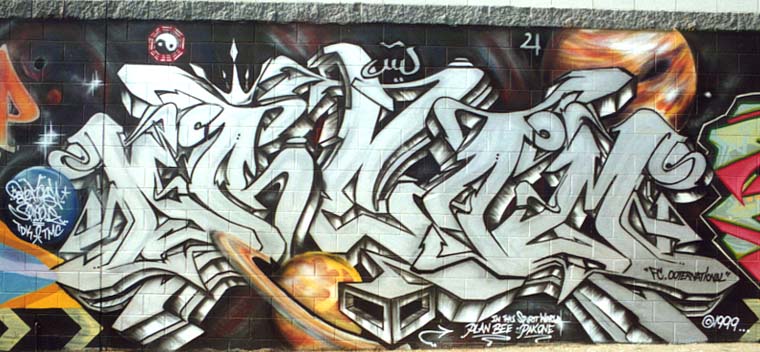
..ffiti.org/sfb/dreamtdkoak.jpg>
..jpg>
..org/sfb/sj04.jpg>
..ffiti.org/sfb/siner-dream.jpg>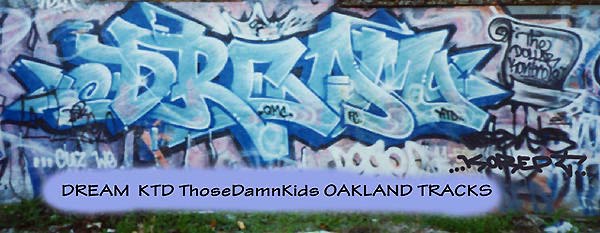
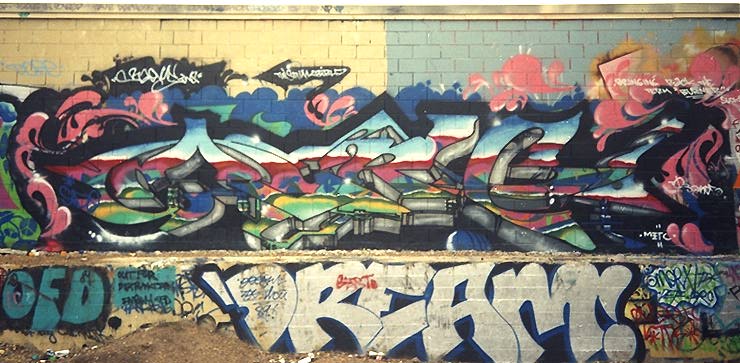
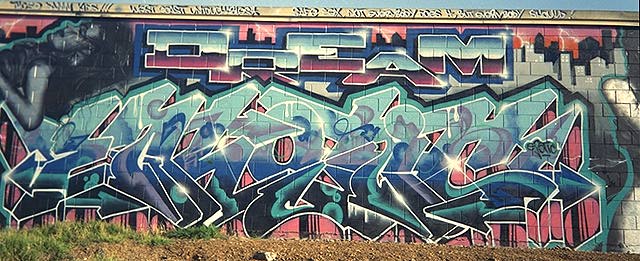
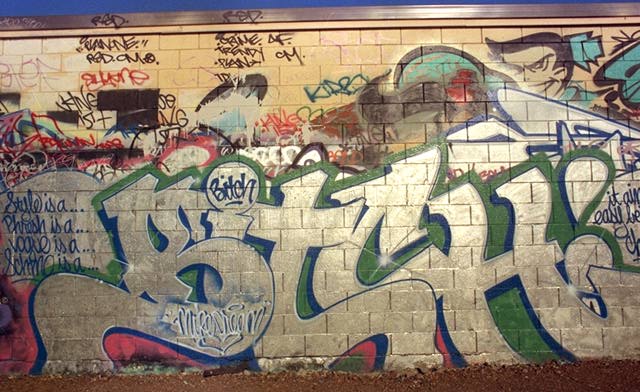

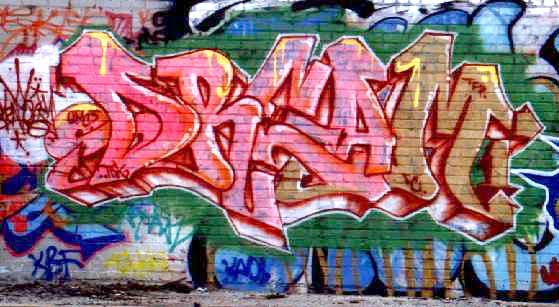
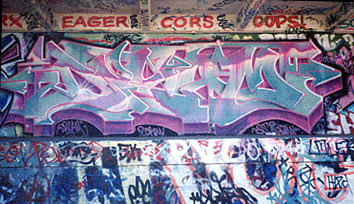
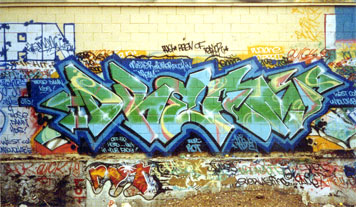
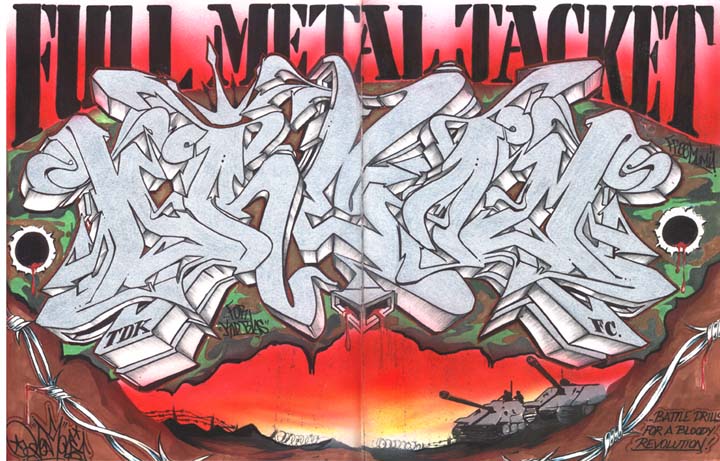
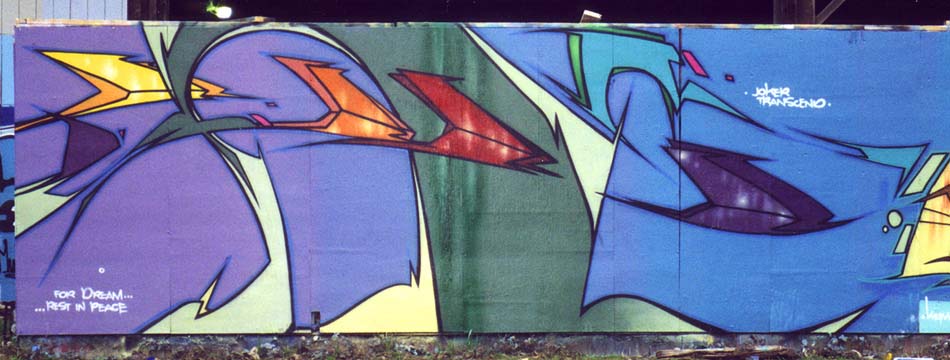




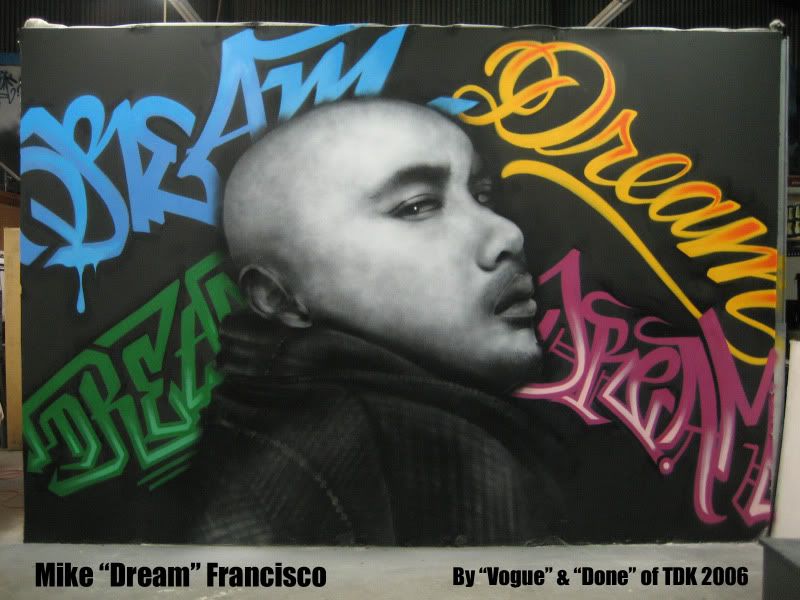



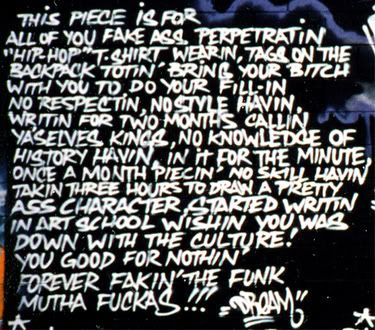
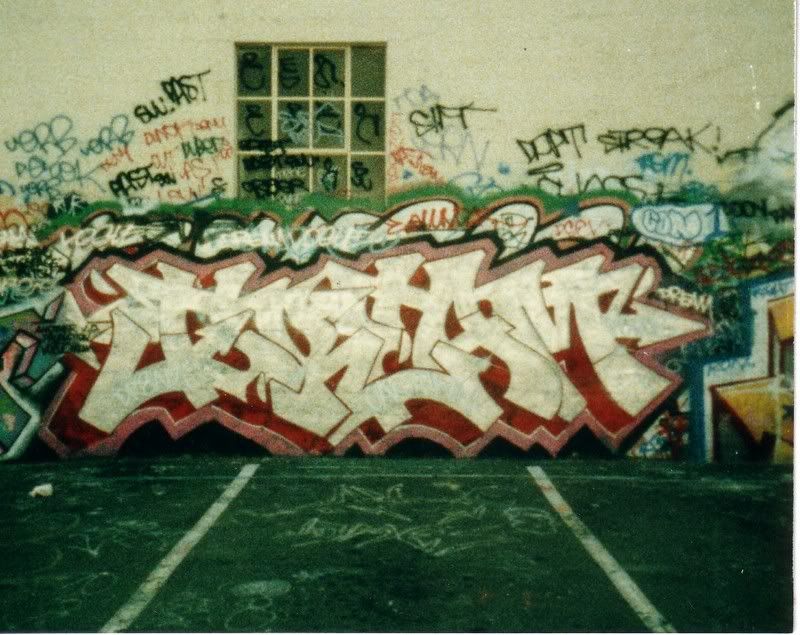


young akil Dream..(right)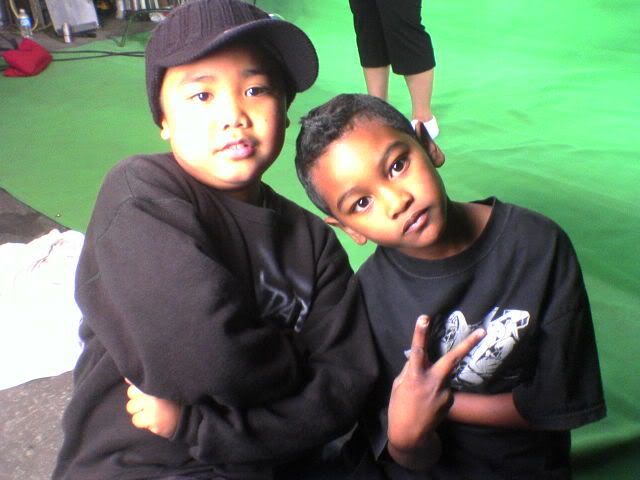
Facebook Badge
Dumpster Television Junkies
vjzombie@gmail.com
Saturday, February 17, 2007
Subscribe to:
Post Comments (Atom)

No comments:
Post a Comment